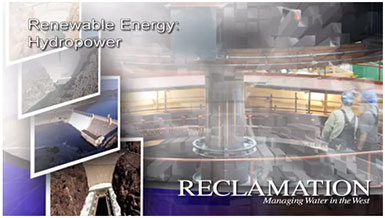Hydropower Program

Reclamation's New Hydropower Video - Hydropower is a reliable resource providing clean energy to the western United States. The Bureau of Reclamation is the second largest producer in the United States. Watch the Reclamation video on hydropower. Video...
Lease of Power Privilege
A Lease of Power Privilege (LOPP) is a contractual right given to a non-federal entity to use a Bureau of Reclamation project facility (e.g. dam or conduit) for electric power generation consistent with Reclamation project purposes. A LOPP project must not impair the efficiency of Reclamation generated power or water deliveries, jeopardize public safety, or negatively affect any other Reclamation project purposes.
The Lease of Power Privilege (LOPP) Processes, Responsibilities, Timelines, and Charges Directive and Standard (D&S) provides clear guidance and timelines on LOPP requirements, assigns roles and responsibilities within the organization for LOPP development, sets a standard methodology across Reclamation for the LOPP charges and identifies all potential charges for developers.
The initial D&S was published in September 2012 - with revisions made in February 2014 to reflect Public Law 113-24 authorities and again in December 206 to clarify LOPP development timeframes and annual charge methodology. A minor revision was made in October 2023 to ensure compliance with Reclamation Manual formatting and content requirements, reflect Public Law 117-58 authorities, clarify LOPP process requirements, and shift existing LOPP solicitation and proposal requirements into a new Appendix (Appendix E).
For additional information, visit the Lease of Power Privilege Website. The website offers guidance for potential developers, stakeholder groups, and Reclamation staff.
Lease of Power Privilege Website
Bureau of Reclamation Hydropower Generation Summary
The Bureau of Reclamation Hydropower Generation Summary identifies federal and non-federal hydropower facilities and associated generating capacity currently online or in development on Reclamation projects – and reports on incremental hydropower capability installed within the reported quarter(s), as applicable. The current release is available below. Previous releases - detailing federal and non-federal hydropower facilities and associated generating capacity currently online or in development on Reclamation projects - are available on the Hydropower Program Reports and Data page.
Bureau of Reclamation Hydropower Generation Summary (FY2025 Q4)
For More Information:
Reclamation Hydropower Strategic Plan
Reclamation has developed a Hydropower Strategic Plan for Fiscal Year 2021-2026. The Strategic Plan, published in December 2020, establishes a vision with complementary goals and objectives that prioritize the value of Reclamation hydropower, maintaining customer satisfaction, and investing in our workforce.
On August 30, 2021, Reclamation published the Hydropower Strategic Action Plan. The Action Plan identifies twelve projects to be undertaken in the next five years to achieve the vision, goals, and objectives of the Strategic Plan.
- Reclamation Hydropower Strategic Plan Fiscal Year 2021-2026
- Reclamation Hydropower Action Plan Fiscal Year 2021-2026
Federal Hydropower Memorandum of Understanding
To help position Federal hydropower to meet the Nation’s need for reliable and affordable renewable hydropower, the Bureau of Reclamation, U.S. Department of Energy's Water Power Technology Office and the U.S. Army Corps of Engineers signed a Federal Hydropower Generation Memorandum of Understanding (MOU) at Hoover Dam August 24, 2020. The MOU provides for a collaborative working relationship that prioritizes similar goals and aligns ongoing and future renewable energy development efforts among the three agencies.
The MOU Action Plan was published in June 2021.
- 2020 Federal Hydropower Memorandum of Understanding (August 2020)
- 2020 Federal Hydropower Memorandum of Understanding Action Plan (June 2021)
- MOU Action Plan Joint Statement (November 2020)
Hydropower Resource Assessments
Reclamation is committed to facilitating the development of non-federal hydropower on Reclamation projects. Acting on this commitment, Reclamation has undertaken a number of activities including the completion of two resource assessments, identifying technical hydropower potential at existing Reclamation facilities.
A number of Resource Assessment sites have been developed by non-federal entities and currently in operation, with many more sites in some stage of active development.
The two assessments and file identifying those Resource Assessment sites available for development are linked below:
- Hydropower Resources Assessment at Existing Reclamation Facilities (March 2011)
- Site Inventory and Hydropower Energy Assessment of Reclamation Owned Conduits (March 2012)
- Hydropower Resource Assessment Sites Available for Development (August 2018)
Non-Hydro Renewable Energy (N-HRE) Projects on Bureau of Reclamation Lands, Facilities, and Waterbodies
Reclamation Manual (RM) Directive and Standard (D&S), Non-Hydro Renewable Energy (N-HRE) Projects on Bureau of Reclamation Lands, Facilities, and Waterbodies (FAC 04-16) has been superseded by RM D&S, Use Authorizations (LND 08-01). LND 08-01 sets forth requirements for issuing use authorization documents allowing others to use land, facilities, and waterbodies under the Bureau of Reclamation’s jurisdiction. Requirements for issuing use authorizations for the purposes of N-HRE development (formerly defined in FAC 04-16) are now addressed in LND 08-01, Paragraph 6.D.(1).
The Use Authorizations for Non-Hydro Renewable Energy on Reclamation Lands guidebook assists Reclamation personnel in screening, processing, and administering use authorizations for N-HRE projects on Reclamation lands consistent with LND 08-01 (formerly FAC 04-16) requirements. Reclamation has designed the guidebook to avoid “reinventing” authorization methodology and help promote consistency among Department of Interior agencies handling N-HRE projects on Federal lands. See both the D&S and guidebook linked below:
- Use Authorizations (LND 08-01)
- Guidebook – Use Authorizations for Non-Hydro Renewable Energy on Reclamation Lands

